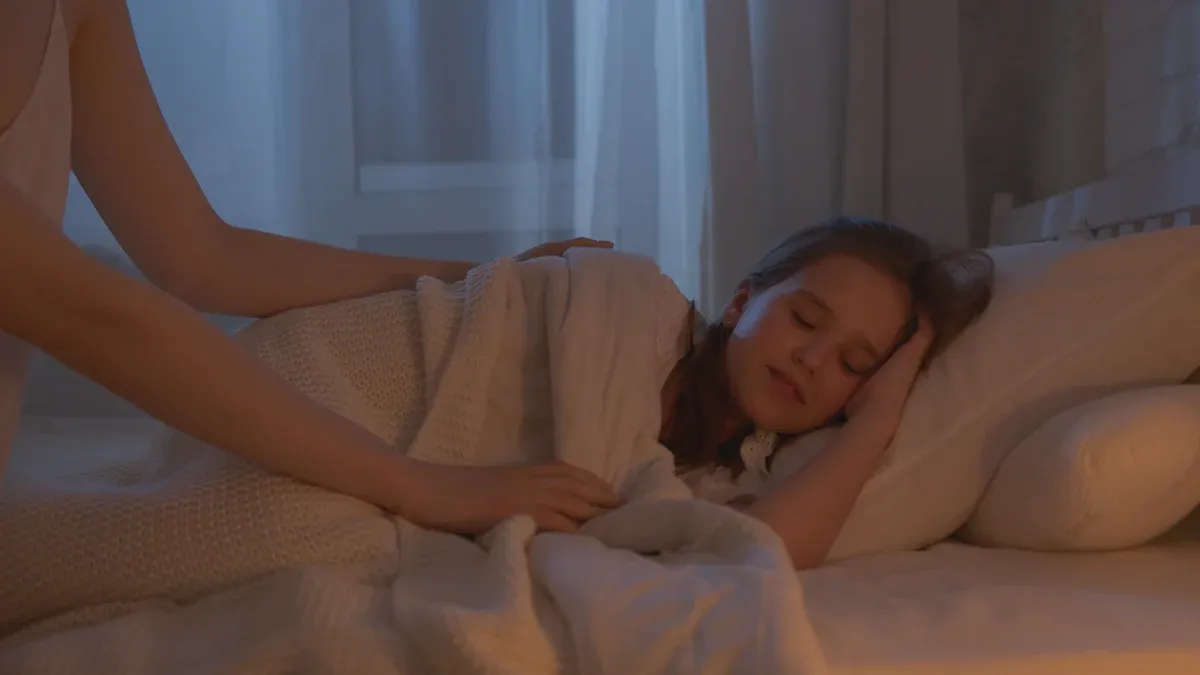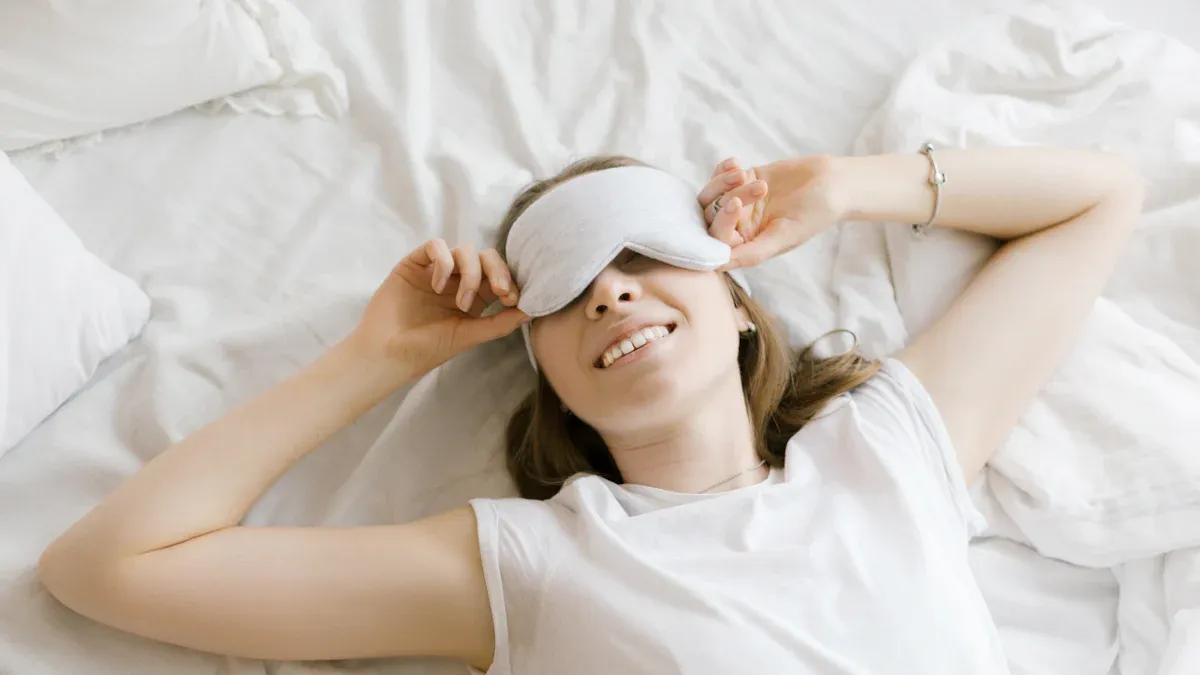
During rapid eye movement sleep, the body and brain change in special ways. Healthy adults spend about 20-25% of their sleep in this stage. The eyes move fast under closed eyelids, and the brain is very active. People often have vivid dreams, but most muscles cannot move. These things help memory, mood, and health. REM sleep is a very important part of sleep every night.
Key Takeaways
-
REM sleep is about 20-25% of adult sleep. It has quick eye movements, strong dreams, and muscle paralysis to keep you safe.
-
REM sleep helps your brain save memories and control feelings. It also keeps you healthy and helps you learn and feel better.
-
Adults need about two hours of REM sleep each night. REM sleep happens in cycles and can change with age and habits.
-
Not getting enough REM sleep can hurt your memory and cause mood swings. It can also raise health risks like high blood pressure and weight gain.
-
Having a steady sleep routine and less stress can help REM sleep. Using tools like the Aura Ring can track sleep and help your health.
REM Sleep Features
Rapid Eye Movement
When REM sleep happens, the eyes move fast under closed eyelids. Scientists call this movement rapid eye movement. These eye movements come in short bursts. Special machines can see these movements. Researchers use polysomnography and electrooculogram to check eye activity. They put sensors near the eyes to watch each movement. The number of movements each minute is called REM density. Studies show these movements often match dream feelings. The brain uses chemicals like acetylcholine to start rapid eye movement. This activity changes heart rate, breathing, and blood pressure. The scanning hypothesis says the eyes move like they are looking around in dreams.
Fun Fact: Rapid eye movement is a main sign of REM sleep. It helps scientists know REM sleep from non-rem sleep.
Dreaming in REM
Most people have strong dreams during REM sleep. Dreams in this stage feel more real and clear than in non-rem sleep. Adults spend about 20 to 25 percent of sleep in REM. REM sleep happens in several parts each night. Dreaming can happen in non-rem sleep, but it is stronger in REM. People remember REM dreams more because they are longer and have more feelings. The brain is very busy, making stories and pictures that seem real. Dreaming helps the brain handle feelings and memories from the day.
Brain Activity
The brain acts almost like it is awake in REM sleep. EEG and scans show some brain parts get very busy. These parts control seeing, feelings, and memory. REM sleep is called paradoxical sleep because the brain looks awake, but the body does not move. Scientists see bursts called PGO waves that start in the brainstem and go to other brain parts. These waves help explain why REM sleep is special. The brain also shows low-voltage, high-frequency waves. These waves do not show up in non-rem sleep. This brain activity helps with learning, memory, and feelings.
-
Key brain features in REM sleep:
-
High activity in vision and emotion areas
-
PGO waves that show REM sleep
-
Brain waves that look like awake waves
-
Muscle Paralysis
During REM sleep, most muscles cannot move for a short time. This muscle atonia stops people from acting out dreams. The brain uses chemicals like GABA and glycine to block motor neurons. This keeps the body still, even when the brain is busy. This safety step keeps people safe during strong dreams. Sometimes, muscle paralysis lasts a few seconds after waking up. This is called sleep paralysis. It can feel scary, but it is normal in REM sleep. In non-rem sleep, the body does not have this much muscle atonia, so moving is easier.
Note: Muscle paralysis in REM sleep keeps people safe. It only happens in REM sleep, not in non-rem sleep.
Rapid Eye Movement Benefits
Memory and Learning
REM sleep plays a key role in helping the brain store new information. During this stage, the brain works to organize and strengthen memories from the day. Scientists have found that REM sleep supports memory consolidation by changing the connections between brain cells. This process helps people remember facts, skills, and even creative solutions to problems.
Studies show that REM sleep has special brain waves and patterns. These patterns help the brain replay and sort through what was learned. For example, the brain repeats activity from earlier in the day, which helps with learning and memory. When people get enough REM sleep, they often do better on tests and remember more details. REM sleep also helps with creative thinking and problem-solving. The brain uses this time to connect ideas and find new solutions.
Tip: Getting enough REM sleep can make it easier to learn new things and remember important information.
Mood and Emotional Health
REM sleep helps the brain manage feelings and stress. During this stage, the brain processes emotions and stores emotional memories. Scientists have found that REM sleep activates areas of the brain that control mood, such as the amygdala and prefrontal cortex. This activity helps people handle stress and keep their emotions balanced.
When people miss out on REM sleep, they may feel more anxious or sad. They might react more strongly to negative events. Studies show that REM sleep helps the brain recover from emotional stress and keeps mood stable. People who get enough REM sleep often feel calmer and more in control of their feelings.
-
REM sleep helps:
-
Process emotional memories
-
Reduce stress
-
Keep mood steady
-
Brain and Body Health
REM sleep supports healthy brain function and body systems. During this stage, the brain uses energy to repair and build important molecules. This helps keep brain function strong and supports growth and development. REM sleep also plays a part in keeping the immune system healthy. When the body fights off illness, REM sleep patterns can change to help the immune system work better.
Scientists have found that certain chemicals, like cytokines, help control sleep and immune function. If people do not get enough REM sleep, their immune system may not work as well. This can make it harder to fight off infections. REM sleep also helps the brain stay healthy by supporting energy use and repair.
Note: REM sleep is not just for the brain. It helps the whole body stay healthy and strong.
REM Sleep Needs
How Much REM Sleep
Most adults need about two hours of REM sleep each night. Experts do not set a fixed number for how much REM sleep you need, but they recommend at least seven hours of total sleep for adults. REM sleep usually makes up 20-25% of this time. The amount of REM sleep changes with age. Newborns spend about half of their sleep in REM, while adults get just over 20%. By age 80, REM sleep drops to about 17%. These changes show that REM sleep needs shift as people grow older.
Tip: Focusing on total sleep time helps ensure enough REM sleep. Getting enough sleep each night supports memory, mood, and health.
Many things can affect how much REM sleep a person gets. Age, sex, and sleep habits all play a role. Women often have longer non-rem sleep episodes, and their REM sleep drops more with age than men. Sleep homeostasis, or the body’s need for rest, also changes REM sleep. After sleep loss, the body may spend more time in non-rem sleep at first, then increase REM sleep later.
-
Key points about how much REM sleep you need:
-
No set number, but aim for at least seven hours of sleep.
-
REM sleep makes up about 20-25% of total sleep.
-
REM sleep decreases with age.
-
Total sleep time matters most for healthy REM sleep.
-
Sleep Cycles
Sleep happens in cycles that repeat through the night. Each sleep cycle lasts about 90 minutes and includes both non-rem and REM sleep. People usually go through four to five REM sleep periods every night. The first REM episode starts about 70 minutes after falling asleep. Early REM periods last around 15 minutes, but later ones can last up to 25 minutes. The amount of REM sleep increases with each cycle.
|
Factor |
Effect on REM Sleep Duration and Quality |
Age Group / Sex |
Notes |
|---|---|---|---|
|
REM sleep duration drops with age; total sleep time falls by about 10-12 minutes per decade in adults |
Adults (19-75 years) |
REM sleep reduction slows after age 60; slight rise in REM between 75-85 years |
|
|
Sex differences |
Women have longer non-rem sleep; greater drop in REM sleep with age than men |
Adults, both sexes |
Women see a bigger increase in Stage 2 sleep with age |
|
Developmental stages |
Infants spend twice as much time in REM sleep as adults; REM helps brain development |
Infants and newborns |
REM sleep drops as sleep patterns mature |
|
Sleep homeostasis |
High sleep pressure increases non-rem sleep early; low pressure leads to longer REM episodes |
All ages |
Sleep pressure changes REM sleep duration |
|
Environmental factors |
Light or noise has little effect on REM sleep in healthy people |
All ages |
Modern life can still reduce total sleep and REM sleep |
Modern life can make it hard to get enough sleep. Long work hours, screen time, and early alarms can cut sleep short. Less sleep means less REM sleep, which can affect memory and mood. People should try to keep a regular sleep schedule and limit late-night screen use to support healthy sleep cycles.
REM Sleep Deficiency
Cognitive Effects
Not getting enough REM sleep can hurt thinking and memory. People might forget things more often or find it hard to learn new stuff. Studies show less REM sleep can shrink some brain parts, like the inferior parietal and precuneus. These brain areas help with memory and are also hurt in diseases like Alzheimer’s. When REM sleep goes down, the brain tries to work harder, but this does not always help. People might make bad choices or react more slowly. Not enough sleep can also mess up how the brain deals with danger and feelings, which can cause mistakes in judgment.
-
Common cognitive effects include:
-
Forgetting things
-
Hard time paying attention
-
Slower reactions
-
Bad choices
-
Emotional Impact
REM sleep helps the brain handle feelings and stress. Without enough REM sleep, people can feel cranky or moody. Not enough REM sleep can cause mood swings and more stress. Over time, missing REM sleep can raise the chance of depression and anxiety. The brain cannot keep strong feelings away from memories as well, so people may get more upset by bad things. This makes it harder to get over stress or emotional pain. Long-term sleep problems can also make mental health issues worse.
Note: Good REM sleep helps people stay calm and deal with stress.
Long-Term Risks
Missing REM sleep for a long time can hurt the brain and body. Not enough REM sleep for many nights can lead to health problems like high blood pressure, weight gain, and heart rhythm troubles like atrial fibrillation. People who do not sleep on a regular schedule can get mood problems, diabetes, and even memory loss. Over time, the brain can lose nerve cells, which makes learning and thinking harder. REM rebound is when the body tries to catch up on lost REM sleep. After not sleeping enough, people may have longer and deeper REM sleep. This helps the brain and body recover, but it cannot fix all the harm from losing REM sleep for a long time.
|
Risk Factor |
Possible Outcome |
|---|---|
|
Chronic REM loss |
Memory loss, mood problems |
|
Irregular sleep |
Weight gain, high blood pressure, anxiety |
|
Long-term deprivation |
Brain cell loss, diabetes |
Good Night’s Sleep Tips

Healthy Sleep Habits
A regular sleep schedule helps the body and brain get the most out of each night. Going to bed and waking up at the same time every day supports the normal cycling of sleep stages. This routine helps increase rem sleep and keeps sleep quality high. People who keep a steady schedule find it easier to fall asleep and stay asleep. A quiet, dark, and cool bedroom also helps create a healthy sleep space. Turning off screens before bed and avoiding caffeine in the evening can make it easier to get a solid night of sleep.
Tip: A regular sleep schedule helps the brain recover, boosts memory, and keeps emotions balanced.
Stress and Lifestyle
Stress can make it hard to fall asleep and can lower sleep quality. Simple stress reduction techniques, like deep breathing or mindfulness, help the body relax. These methods calm the mind and support healthy sleep. Studies show that people who practice relaxation before bed often see an increase in rem sleep. Exercise during the day and spending time outside also help the body prepare for a good night's sleep.
Sleep Tracking with Aura Ring
Tracking sleep can help people understand their sleep patterns and improve sleep quality. The Aura Ring by VERTU offers a stylish way to monitor sleep, heart rate, and other health signs. Its crystal composite design feels light and comfortable, so users can wear it all night. The Aura Ring uses AI health monitoring to give clear feedback about rem sleep and overall sleep quality. Weekly wellness reports and expert support help users make better choices for healthy sleep. This smart ring helps people see how their habits affect their sleep and find ways to increase rem sleep.
When to Seek Help
Some people may have trouble with rem sleep that does not improve with healthy habits. They should look for help if they act out dreams, feel very tired during the day, or cannot get a good night's sleep. Sleep specialists and therapists can check for sleep disorders and offer treatment. Safety at home is important for those with rem sleep behavior disorder. Padding furniture and removing sharp objects can help prevent injury. Support groups and online therapy can also help people manage sleep problems.
REM sleep is very important for the brain, memory, and mood. Studies show REM sleep helps with feelings, learning, and mental health.
-
REM sleep lets the brain handle emotions and make good choices.
-
Having good sleep habits and a set routine makes REM sleep better.
-
Devices like the VERTU Aura Ring help people watch their sleep and learn how to rest and stay healthy.
Focusing on REM sleep can help people feel smarter, more relaxed, and healthier each day.
FAQ
What is the difference between dreaming and daydreaming?
Dreaming happens at night when you are asleep. Daydreaming happens when you are awake. Both times, the brain makes up stories. Only dreams at night change your body and eye movement.
Why do people sometimes feel unable to move when waking up?
Some people wake up and cannot move for a short time. This is called sleep paralysis. It lasts just a few seconds and then stops by itself.
Can children have more vivid dreams than adults?
Children often say their dreams are brighter and more active. Their brains grow fast, so their dreams can feel stronger. As people get older, dreams may not happen as much or feel as real.
How can someone improve the quality of their dreams?
Going to bed at the same time helps dreams. A quiet room and less screen time before sleep also help. Doing things like deep breathing can make dreams better.
When should someone talk to a doctor about their dreams?
If bad dreams happen a lot or cause fear in the day, see a doctor. Many nightmares or acting out dreams could mean a health problem.






